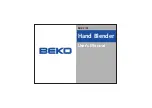
24
1.0
System Pressure Higher than Desired Set Point
1.1
Primary Causes
a) Insufficient pressure on top side of diaphragm.
b) Leakage through main valve seat
c) Pressure build-up due to thermal expansion, such
as caused by volumetric expansion of the water in
a heater connected to the system side of the PRV.
d) Inaccurate system pressure signal.
1.2
Tests and Remedies (see Figure 1 for item numbers)
a) Install gauge, install on CRD (Item 6), if necessary.
b) Vent air from air vent (Item 9) and from other high
points of PRV trim. Valve cover bolts may have to
be loosened on some units with PRV mounted
horizontally.
c) Check CRD set point adjustment.
d) Close stop cock (Item 7) in check line. If PRV now
operates properly, clean or replace adjacent check
valve (Item 8).
e) Inspect CRD (Item 5) disc and seat for proper
seating.
f) Inspect strainer (Item 1) that the screen is clean.
g) Inspect orifice (Item 3) that it is not clogged.
h) Plug outlet side of CRD. If main valve closed tight,
the problem most likely is in the CRD. Replace
same. If the main valve does not close tight, disas-
semble it for inspection. Check for scored seat.
2.0
System Pressure Lower than Desired Set Point
2.1
Primary Causes
a) Excessive pressure on top side of diaphragm.
b) Suction pressure below design conditions (check
nameplate on panel door for design conditions).
c) Desired system pressure is higher than design
condition (check panel nameplate).
d) Flow Rate is greater than design condition.
e) Inaccurate system pressure signal.
2.2
Tests and Remedies (see Figure 1 for item numbers)
a) Install gauge, install on CRD (Item 6), if necessary.
b) Vent air from air vent and all high points.
c) CRD disc guide or yoke binding.
d) Check motor amps. If greater than full load amps
(motor nameplate), flow rate may be greater than
design.
e) Leak into upper diaphragm chamber. Close stop
cock (Item 7) and remove a connection between
the flow control valve (Item 4) and the PRV valve
cover. Plug the flow control side. Open pump suc-
tion valve and start pump. If water emits from the
valve cover plate, there is a leak passing the
diaphragm into the upper chamber.
f) Remove valve cover plate for inspection. Remove
“cancerous” buildups which may prevent dia-
phragm from lifting fully. Check for binding of
valve stem assembly.
g) Opening speed control valve (Item 4) clogged in
restricted flow mode (out of PRV valve cover).
h) Orifice (Item 3) missing. The orifice fitting identical
in appearance to a flare to MPT adapter, therefore
may have been inadvertently replaced or mis-
placed during valve service.
i) Check pump discharge pressure. Does it corre-
spond to the TDH curve?
3.0
System Pressure Slow to Recover
from Under Pressure to Set Point
3.1
Primary Causes
a) Pressure above the diaphragm is not being re-
moved quickly enough.
b) Mechanical binding in main PRV or CRD pilot
valve.
c) Excessive suction supply line pressure drop.
3.2
Remedies (see Figure 1 for item numbers)
a) Any of the items of 2.2 may be a contributing factor.
b) Readjust flow control valve (Item 4) to less restric-
tive setting, turn counter clockwise.
NOTE: Forcing the stem too far CCW will shear the
stem snap ring and cause the stem to blow out.
Recommend that the stem be initially turned CW,
noting the number of turns required to seat the stem,
then backing it out CCW a few more turns than the
original setting. The maximum CCW setting is about
9 turns.
4.0
System Pressure Overshoots Greatly
and Slow to Recover to Set Point
4.1
Primary Causes
a) Pressure above the diaphragm is not being ap-
plied soon enough.
b) Mechanical binding in main PRV or CRD pilot
valve.
c) Leaky seat in main PRV or CRD valves.
d) Excessive suction supply line pressure drop.
e) System side surge (water hammer) due to sudden
closure of a quick opening valve.
f) Strainer (Item 1) clogged.
4.2
Remedies (see Figure 1 for item numbers)
a) Any of the items of 1.2 may be contributing factors.
b) Install larger orifice (Item 3).
APPENDIX D
TROUBLESHOOTING COMBINATION – PRESSURE REDUCING AND CHECK VALVES
DANGER: Troubleshooting live control panels ex-
poses personnel to hazardous voltages. Electrical
troubleshooting must only be done by a qualified electri-
cian. Failure to follow these instructions could result in
serious personal injury, death, and/or property damage.





































